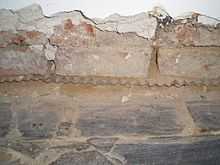Damp proofing

Damp proofing in construction is a type of waterproofing applied to building walls and floors to prevent moisture from passing into the interior spaces. Damp problems are one of the most frequent problems encountered in homes.
Overview

Damp proofing is accomplished several ways including:
- A damp-proof course (often abbreviated to DPC) is a barrier in a wall designed to resist moisture rising through the structure by capillary action such as through a phenomenon known as rising damp using materials listed below. The damp proof course may be horizontal or vertical.[1] A damp-proof membrane (DPM) may be used for the DPC. Moisture resistance is not necessarily absolute: it is usually defined by a specific test method, limits, and engineering tolerances. A DPC layer is usually laid below all the walls, regardless of the issue that the respective wall is a load bearing wall or a partition wall.
- Integral damp proofing in concrete involves adding waterproofing materials to the concrete mix to make the concrete itself a water barrier.[1]
- Surface coating with thin water proof materials for resistance to non-pressurized moisture such as rain water or a coating of cement sprayed on such as shotcrete which can resist water under pressure.[1]
- Cavity wall construction, such as rainscreen construction, is where the interior walls are separated from the exterior walls by a cavity.[1]
- Pressure grouting cracks and joints in masonry materials.[1]
Materials
Materials widely used for damp proofing include:[2]
- Flexible materials like butyl rubber, hot bitumen, plastic sheets, bituminous felts, sheets of lead, copper, etc.
- Semi-rigid materials like mastic asphalt
- Rigid materials like impervious bricks, stones, slates, cement mortar or cement concrete painted with bitumen, etc.
- Stones
- Mortar with waterproofing compounds
- Coarse sand layers under floors
- Continuous plastic sheets under floors
Construction
A DPC is usually a thick plastic strip bedded into the mortar between two courses of bricks or blocks. It can often be seen as a thin plastic line in the mortar near ground level.
A DPM is usually a thick polythene sheet laid under the floor slab, to allow the slab to dry out and keep out groundwater. It is often laid on a bed of sand, to prevent the sharp edges of the hardcore damaging it.
To create a continuous barrier, pieces of DPC or DPM are welded together. In addition, the DPC is welded to the DPM around the outside edges of the ground floor, completely sealing the inside of the building from the damp ground under it.
In a cavity wall, there is usually a DPC in both the outer and inner wall. In the outer wall it is normally 150-200mm above ground level (the height of 2-3 brick courses). This allows rain to form puddles and splash up off the ground, without saturating the wall above DPC level. The wall below the DPC may become saturated in rainy weather. The DPC in the inner wall is usually below floor level, (under a suspended timber floor structure), or, with a solid concrete floor, it is usually found immediately above the floor slab so that it can be linked to the DPM under the floor slab. This enables installation of skirting boards above floor level without fear of puncturing it. Alternatively, instead of fitting separate inner and outer DPCs, it is common in commercial housebuilding to use a one-piece length of rigid plastic, (albeit an angled section), which fits neatly across the cavity and slots into both walls (a cavity tray). This method requires the need for weep vents to enable rainwater ingress to drain from the cavities otherwise rising dampness could occur from above the DPC.
Remedial Damp Proofing
Until the 20th Century masonry buildings in Europe and North America were generally constructed from highly permeable materials such as stone and lime-based mortars and renders covered with soft water-based paints which all allowed any damp to diffuse into the air without damage. The later application of impermeable materials which prevent the natural dispersion of damp, such as tiles, linoleum, cement and gypsum-based materials and synthetic paints is thought by some to be the most significant cause of damp problems in older buildings.[3]
There are many solutions for dealing with dampness in existing buildings, the choice of which will largely be determined by the types of dampness that are affecting the building (e.g. rising damp, hygroscopic damp, condensation, penetrating damp etc...). These are described in more detail under Damp (Structural).
Health and safety
Some DPC materials may contain asbestos fibres. This was more commonly found in the older, grey sealants as well as flexible tar boards.
Other possibly hazardous materials include the use of lead sheets as a DPC material.
References
- ↑ 1.0 1.1 1.2 1.3 1.4 Punmia, B. C., A. K. Jain, and Arun Kumar Jain. Building construction. 10th ed. New Delhi: Laxmi Pub., 2008. 631. Print.
- ↑ P.C. Varghese (2005). Building Materials. PHI Learning Pvt. Ltd. p. 230. ISBN 81-203-2848-5.
- ↑ Society of the Protection of Ancient Buildings. "Technical Q&A 20: Rising Damp". Retrieved 16 July 2013.
9. Damp Proofing without structural change.